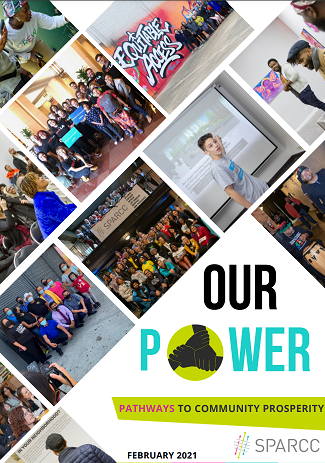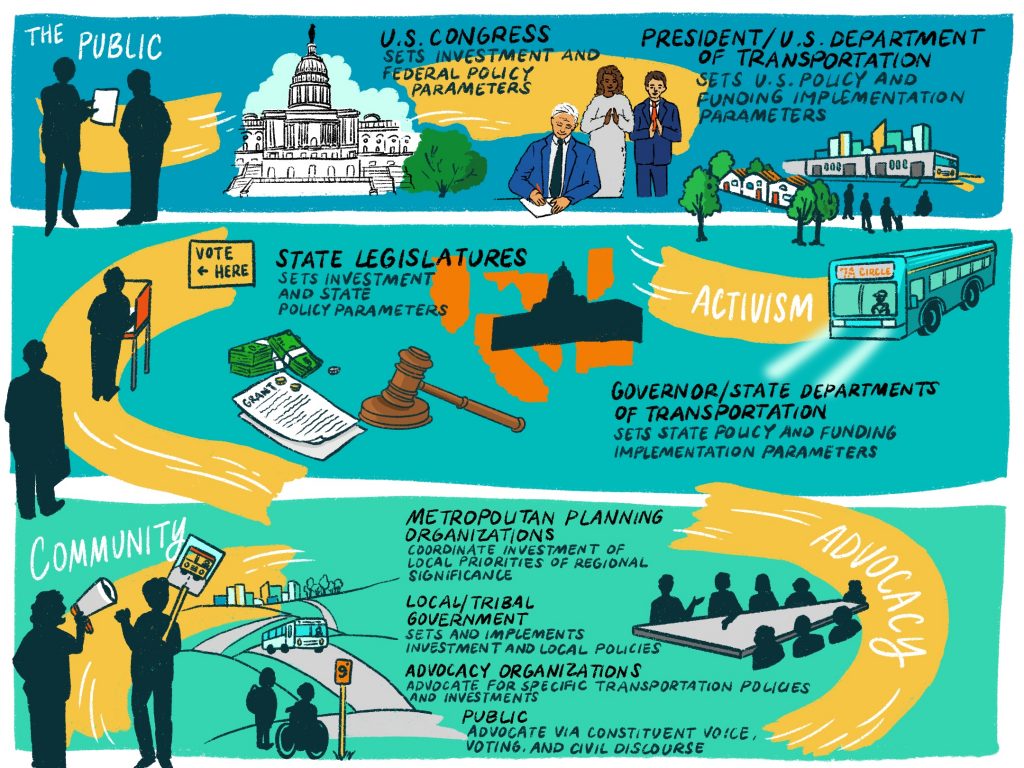By Sasha Forbes and Nick Collins
At SPARCC’s inception, we knew policy—local, regional, and national—would be a critical component for long-term systems change. But that was met with the hard reality of the 2016 election, which put many policy advocates on the defense. Where we had high hopes for an administration to work with us in implementing new policies to advance racial justice we were met with not only resistance, but with the threat of rolling back standards like the Community Reinvestment Act, National Environmental Policy Act, and Affirmatively Furthering Fair Housing.
We were also navigating a brand-new initiative, comprised of four large national organizations and six regional collaboratives in Atlanta, Chicago, Denver, Los Angeles, Memphis and the San Francisco Bay Area. A lot of early time was spent trying to find our voice and what that voice represented in advancing racial justice—especially since the larger national organizations operated in white dominant frameworks and the conversation around race was still much newer then than it is now. Much of the push on the national organizations toward a more justice-oriented voice came from local organizations involved in the collaborative table structure and internal SPARCC staff members. As internal staff members we knew the inherent responsibility to honor the goal on advancing racial equity, honor the local partners, and hold our own organizations accountable to the promises of the initiative. This was difficult work, that often involved a lot of emotional conversations and comprehensive case making. It also took time.
Even as we worked through internal conversations around voice and navigated a hostile federal administration, the regional tables identified and named a number of policy priorities. Each regional table is comprised of many local partners, so the policy priorities were as diverse as the cities they worked in—from equitable transit-oriented development to addressing the enduring legacy of racially discriminatory housing policy, the policy experts and community issues ran the gamut. It was a garden full of many different flowers, but from an initiative perspective, it meant we were trying to tackle a lot. It was hard to explain to funders, organizations, or potential partners our exact policy topic beyond advancing racial equity, climate, and health in our work. One month we’re championing our Principles for Parks and Equitable Development, and the next we’re talking about parking implications on policy. From our perspective, these disparate things were always deeply connected—how we experience our parks is deeply intertwined with race, health, climate, and—yes! —parking.

But the garden was big—like, really big—and it had A LOT of gardeners tending to many types of plants. The question ahead of us was how to make our garden more accessible without trampling over those plants or kicking any gardeners out. Through a collaborative process with national and local organizations, we worked together to identify common threads between our myriad policy focuses. That months-long project eventually led us to co-create our policy platform, Pathways to Community Prosperity. The platform is an example of collective power-building, and was organized to:
- Center race and elevate intersectional policies that advance health equity and climate justice.
- Focus on the immediate needs of people and communities and elevate local ideas for equitable and just recovery and development.
- Offer recommendations to achieve greater local control and community ownership.
- Serve as a tool for coordination and collaboration between local and national partners.
- Include policies that are implementable and actionable across the collective SPARCC communities and across various local, state, and national levels.
The four focus areas—our common seeds—were identified as:
- Restorative and Regenerative Economy
- Housing as a Human Right
- Equitable Transit-Oriented Development (ETOD)
- Parks and Open Space Equity
Across each of these focus areas, you’ll find the central principle of community ownership—of not just land, but decision-making processes and governance—is a key component of the kinds of policies necessary. This was also in direct response to reframing our conversation on anti-displacement and gentrification, which was a common issue across the regions. In time, the policy platform became the sunflower in our garden: a central set of principles and concepts we could point to describe the miraculous garden we had been growing together.
With our combined life and policy experiences and our vision set by the end of 2020, SPARCC was primed to offer its lessons and learnings to a new administration. We offered a set of principles that was helpful in providing grounding through our Principles for an Equitable and Just Recovery. We’re excited to share just a few of the fruits of our collective labor.
Making Federal Funding More Equitable
Through increased direct community connections between community-based organizations and federal agencies (like HUD, DOI, EPA, and DOT), we have been able to encourage the administration to make federal funding more accessible and equitable. These connections help to improve the flow of information between federal agencies to increase understanding of what communities actually want, better understand barriers to influencing and accessing federal resources and recommendations of policies that need to be changed. Through bill analysis, engaging staff and submitting comments on programs like the Greenhouse Gas Reduction Fund or recommendations for parks and public lands justice, we’re working to ensure that federal resources like Infrastructure Investment and Jobs Act (IIJA), Inflation Reduction Act (IRA), and annual appropriations money goes where it needs to go: into the hands of community-based organizations to both access funding and/or influence investments. We’ve also connected with the administration on the Justice40 Initiative, the Thriving Communities Program and strategies to advance long-term community stewardship by funding and following the leadership of more BIPOC led and centered organizations.

Following the 2020 election, we also witnessed the transition of staff from local, regional, and national SPARCC affiliated groups to municipal and federal government positions, where their focus on racial equity, climate equity, and health equity was called front-and-center by the new administration. Because of these shifts, we believe that the experiences of community health workers, transit and housing equity advocates, and community land trust leaders via the SPARCC capital pipeline was better reflected in legislation like Build Back Better.
Supporting the Passage of Many Local Policies and Funds
Advocates in SPARCC regions have been able to pass an incredible number of local policies that advance housing, climate, park equity, equitable transit, and community ownership. While the majority of the work has been done by local partners themselves, our resources and support have been an important “but for” element in a number of local ordinances. This includes a $10 million equitable transit-oriented development fund in Chicago, $14 million for community stewardship of land in Los Angeles County, $1 billion for affordable housing in the San Francisco Bay Area, and the formation of the Federal Health Equity for All Coalition.
Connecting Local Policy Advocates
We supported a network of local policy advocates who are working on distinctly different things from each other, but are still operating in systems influenced by actions on the federal level. To increase collective impact, local policy leaders asked that we focus on helping to bridge the federal work by crowdsourcing comments for policy proposals and to generate feedback on policies that are actually focused on communities. There was a strong network of policy advocates overseeing incredible legislation at the city, regional, and state levels– but like many nonprofit activists, they’re stretched thin. Most frontline and community-based organizations do not necessarily have the time to spend hours poring over a federal policy proposal and or to form relationships with key administrative people. But key to our role was understanding where we could add value in building relationships as an intermediary. By devoting our time and energy to sharing federal policy information to our local counterparts, we provided an easier way to engage and influence future federal policy decisions—and, most importantly, keep community centered in policy. This also made it easier for local organizations to connect with each other and share local actions in response to federal actions for cross-site collaboration.
Watering the Garden
While SPARCC’s funding is formally ending, our relationships and work moves forward. With the more than $3 trillion dollars in federal investments flowing to community in the next four years and the persistent way inequity continues to worsen our racial divide, especially with our climate crisis, we must continue pushing together with frontline and community-based leaders to advance all the issues in our garden. Our policy platform will remain an organizing principle for that work because we know it is relevant—it is intersectional, locally-generated, and co-created with the kind of policies that we need to pursue if we want to create a nation where everyone thrives.